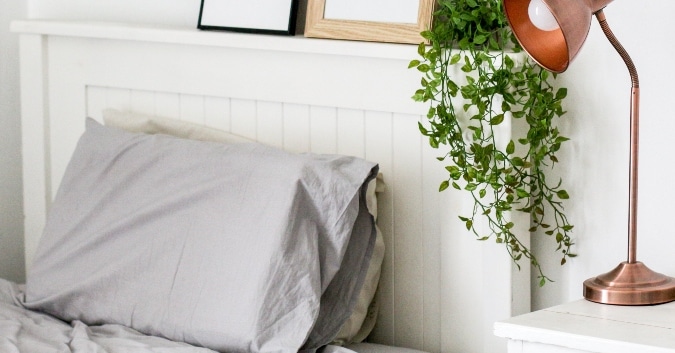A new mattress is an investment in your health. Replacing your old and worn-out mattress can enhance your sleep quality. According to a 2009 National Library of Medicine study, Verified Source National Library of Medicine (NIH) World’s largest medical library, making biomedical data and information more accessible. View source a new bed can improve back pain, reduce stress, and help you sleep well through the night. A good night’s sleep goes a long way to keep you mentally and physically healthy.
We recommend replacing your mattress every 6 to 8 years. Though not all mattresses last the same amount of time, most high-quality mattresses last about that long. With proper maintenance and care, some even last more than 10 years.
Signs It’s Time to Replace Your Mattress
When your mattress no longer supports your body the way it used to, you’ll start feeling uncomfortable in bed. This discomfort during sleep may be the earliest sign it’s time to replace your mattress. With time, you may start noticing some other signs of wear on your mattress.
If you see or feel any of the following signs, it’s probably time to replace your mattress. Depending on the mattress type, material quality, and how well you maintain it, you may notice these signs within 2 to 10 years of buying your mattress.
You Notice Indents
It’s pretty easy to spot mattress indentations and sagging. If you see an indent on your mattress in the shape of your body, the life of your mattress may be expiring. These sags are also visible on the edges of your mattress from getting in and out of bed
All types of mattresses such as latex, memory foam, innerspring, and hybrids sag with time. The components of the mattress break down with age, causing mattress sagging. Mattress foams and cushioning materials become soft with prolonged use. Coils in the traditional innerspring and hybrid mattresses start losing tension and break with time, affecting mattress durability.
Mattresses with soft spots and sags are no longer in good condition. The deeper the indents on your mattress, the more the discomfort.
You Feel Exhausted
You may be going to bed and waking up at your usual time, but an uncomfortable sleep surface prevents you from sleeping well through the night. If you wake up feeling exhausted even if you got a full 7-8 hours of sleep, chances are your mattress is the culprit.
You Wake Up Sore
When you sleep, your head, neck, and spine should be aligned. But a worn-out mattress lacks sufficient contouring, causing spinal misalignment. Spinal misalignment triggers back pain, neck aches, or muscle stiffness. If you are waking up sore regularly, then it’s probably time to replace your mattress.
Your Allergies Flare Up
Every normal human sheds dead skin cells. Considering we spent 7 to 9 hours on the bed, numerous skin cells accumulate in our mattress. Dead skin cells attract dust mites, fungi, bacteria, and other indoor allergens. These allergens can trigger symptoms such as itchy throat, runny nose, watery eyes, sneezing, coughing, breathing difficulties, and skin irritation. Old mattresses may have a lot of allergen build-up. If it’s not allergy season and you are waking up with aggravated allergies, then it’s time to consider replacing your mattress.
Your Mattress Is Noisy

Springs making squeaky noise when you move is a sign of wear. Worn-out springs can’t provide adequate support, making your bed uncomfortable. To avoid this problem in the future, consider a memory or latex foam mattress with no springs.
You Feel More Comfortable on a Different Bed
Sometimes we get used to the discomfort. We don’t realize our mattress is uncomfortable until we sleep on another bed and feel much better than our own bed. If you get better sleep on your couch or in a different bed, it may be time to assess your mattress’s condition.
Why You Should Replace Your Mattress
A comfortable mattress with the right balance of cushion and support is crucial for a good night’s sleep. If we don’t sleep well through the night, our daytime productivity goes down. Insufficient sleep also impairs our health in many ways. Here are some of the health consequences of poor sleep:
- Increased risk of diabetes, kidney, and heart disease
- Higher risk of Alzheimer’s disease
- Daytime drowsiness (dangerous while driving)
- Risk of obesity
- Triggers anxiety, depression, and mood swings
- Weakens immune system
How Often Should You Replace Different Mattress Types?
A lot of a mattress’s durability depends on the quality of materials and how well you maintain it. Some materials last longer than others. In this section, we discuss the most popular mattress types and their average lifespan.
Innerspring Mattresses
These traditional innerspring beds contain a coil layer at the base, topped with a thin comfort layer made of cotton or wool. Most innerspring mattresses also include a pillow top, an extra layer of padding on the comfort layer. The padding consists of foam, memory foam, latex, fiberfill, cotton, or wool.
A good quality innerspring bed can last up to 10 years. But mattresses with cheaper quality coils don’t last long because the coils break, causing mattress sag.
Memory Foam Mattresses
Memory foam mattresses were introduced on the market about three decades ago. Since then they have been popular for their signature body-conforming hug. Memory foam is temperature and pressure-sensitive. It responds to your body heat and forms to your curves, relieving pressure points, and reducing aches.
High-quality memory foam mattresses can last up to 15 to 20 years with proper care.
Latex Mattresses
Latex mattresses are made of either all-natural latex from the sap of rubber trees, or from synthetic latex. We recommend natural latex because synthetic latex foam disintegrates faster, affecting mattress durability. Natural latex is used in organic beds. Organic beds are made using natural materials, minimizing chemical use.
These mattresses are expensive but they can last 15 to 20 years or more.
Hybrid Mattresses
Hybrid mattresses include a pocket coil layer at the base with more than 2 inches of comfort layer on top. Memory foam or latex is used in the comfort layer. As their name suggests, hybrid mattresses combine the advantages of an innerspring mattress with memory foam or latex bed.
Hybrids last around 8 to 10 years. Their durability depends on the coil layer’s quality.
Tips to Prolong Your Mattress’s Life
Mattresses age with time. Some signs of wear are bound to show up eventually. Following these tips can extend mattress durability by a few more years.
- Wash your bedding weekly.
- Use a mattress protector, reducing the chances of spills, sweat, body oil, and allergens permeating to your mattress. Wash it once every two weeks.
- Vacuum your mattress with the upholstery attachment, once every three months.
- Baking soda neutralizes odors, keeping your mattress fresh. Once every six months, sprinkle baking soda on your mattress. Let it sit for 10 to 24 hours. Vacuum it clean to remove the baking soda.
- Rotate your mattress every three to six months, preventing excessive wear on certain parts.
- Support your mattress with the correct foundation. For innersprings, that’s a box spring. For all other mattress types, use a metal frame, adjustable base, or platform. Slats on the platform bed should be no more than 3 inches apart for even support.
- Keep your mattress upright when cleaning or moving it, to prevent bending and damaging it.
- Never let children jump on your mattress. Standing and jumping causes excessive pressure and eventual sagging.
- Use mattress pads and toppers to minimize direct pressure on the mattress. A high-quality mattress topper can also help you adjust the firmness of your mattress.
FAQs
Can a mattress last 20 years?
Some mattresses come with a 20 to 25-year warranty. With proper care, these mattresses may last that long. Mattress durability depends on factors such as the quality of materials used and how well the mattress is maintained. Usually, good quality memory foam and latex mattresses last 15 years or more, longer than average innerspring mattresses.
How do I know if my mattress is worn out?
If you are waking up sore often, chances are your mattress has sags, lumps, or soft spots. These are signs of mattress wear. On an innerspring bed, noisy coils are also a sign of the coil layer wearing out. Worn out coils can’t support your mattress, causing sag.
How long should a mattress last?
Your mattress’s life depends on how well it’s cared for and the quality of the materials used to make it. Innerspring and hybrid mattresses can last around 7 to 10 years, depending on the strength of the coil layer at the base. Good quality memory foam and all-natural latex foam mattresses last about 10 to 15 years or more. Keep a mattress as long as it’s comfortable and supportive.
Why should you replace your mattress?
You should replace your mattress for your well-being. A sagging sleep surface can’t support your body properly, causing sleep disruptions. Insufficient sleep affects daytime productivity. Prolonged sleep disruptions trigger several physical and mental health problems.
Are you supposed to flip your mattress?
You can flip your mattress only if it is a double-sided mattress. Double-sided mattresses need to be flipped at least twice a year and rotated every three months, for even wear. Most mattresses are usually one-sided. Ask the salespersons or customer service representatives of the mattress manufacturers if the mattress is two-sided.
Conclusion
Even the best mattresses in the mattress industry can’t last forever. The materials used in making mattresses disintegrate with time. Regular vacuuming, washing bedding accessories weekly, and using mattress protectors can delay mattress wear. But eventually, you’ll have to replace your old mattress to keep getting good sleep.
About the author
Sanchita Sen is a full-time writer focusing on the sleep health and mattress industry. She is a former journalist who has written numerous articles on the healthcare sector. Some of the topics she has covered include how to lucid dream, fever dreams, melatonin for sleep, and best gel memory foam mattress. Sanchita holds a Master of Arts in Communications from Convergence Institute of Mass Media and Information Technology Studies. She is also a published author, who seeks inspiration from both real life and the world of fiction.
View all posts





